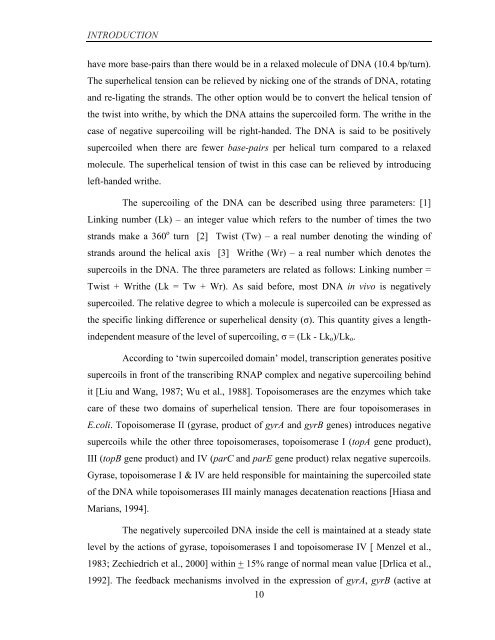Coordinated regulation of gene expression by E ... - Jacobs University
Coordinated regulation of gene expression by E ... - Jacobs University
Coordinated regulation of gene expression by E ... - Jacobs University
Create successful ePaper yourself
Turn your PDF publications into a flip-book with our unique Google optimized e-Paper software.
INTRODUCTION<br />
have more base-pairs than there would be in a relaxed molecule <strong>of</strong> DNA (10.4 bp/turn).<br />
The superhelical tension can be relieved <strong>by</strong> nicking one <strong>of</strong> the strands <strong>of</strong> DNA, rotating<br />
and re-ligating the strands. The other option would be to convert the helical tension <strong>of</strong><br />
the twist into writhe, <strong>by</strong> which the DNA attains the supercoiled form. The writhe in the<br />
case <strong>of</strong> negative supercoiling will be right-handed. The DNA is said to be positively<br />
supercoiled when there are fewer base-pairs per helical turn compared to a relaxed<br />
molecule. The superhelical tension <strong>of</strong> twist in this case can be relieved <strong>by</strong> introducing<br />
left-handed writhe.<br />
The supercoiling <strong>of</strong> the DNA can be described using three parameters: [1]<br />
Linking number (Lk) – an integer value which refers to the number <strong>of</strong> times the two<br />
strands make a 360 o turn [2] Twist (Tw) – a real number denoting the winding <strong>of</strong><br />
strands around the helical axis [3] Writhe (Wr) – a real number which denotes the<br />
supercoils in the DNA. The three parameters are related as follows: Linking number =<br />
Twist + Writhe (Lk = Tw + Wr). As said before, most DNA in vivo is negatively<br />
supercoiled. The relative degree to which a molecule is supercoiled can be expressed as<br />
the specific linking difference or superhelical density (σ). This quantity gives a lengthindependent<br />
measure <strong>of</strong> the level <strong>of</strong> supercoiling, σ = (Lk - Lk o )/Lk o .<br />
According to ‘twin supercoiled domain’ model, transcription <strong>gene</strong>rates positive<br />
supercoils in front <strong>of</strong> the transcribing RNAP complex and negative supercoiling behind<br />
it [Liu and Wang, 1987; Wu et al., 1988]. Topoisomerases are the enzymes which take<br />
care <strong>of</strong> these two domains <strong>of</strong> superhelical tension. There are four topoisomerases in<br />
E.coli. Topoisomerase II (gyrase, product <strong>of</strong> gyrA and gyrB <strong>gene</strong>s) introduces negative<br />
supercoils while the other three topoisomerases, topoisomerase I (topA <strong>gene</strong> product),<br />
III (topB <strong>gene</strong> product) and IV (parC and parE <strong>gene</strong> product) relax negative supercoils.<br />
Gyrase, topoisomerase I & IV are held responsible for maintaining the supercoiled state<br />
<strong>of</strong> the DNA while topoisomerases III mainly manages decatenation reactions [Hiasa and<br />
Marians, 1994].<br />
The negatively supercoiled DNA inside the cell is maintained at a steady state<br />
level <strong>by</strong> the actions <strong>of</strong> gyrase, topoisomerases I and topoisomerase IV [ Menzel et al.,<br />
1983; Zechiedrich et al., 2000] within + 15% range <strong>of</strong> normal mean value [Drlica et al.,<br />
1992]. The feedback mechanisms involved in the <strong>expression</strong> <strong>of</strong> gyrA, gyrB (active at<br />
10
















